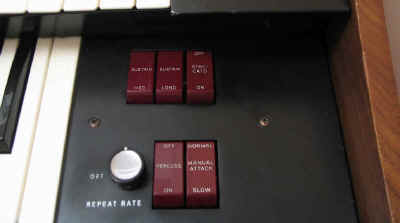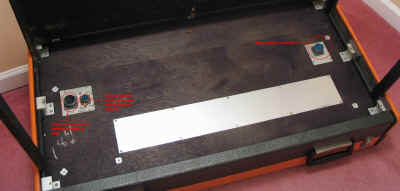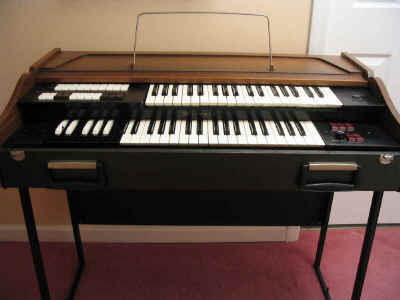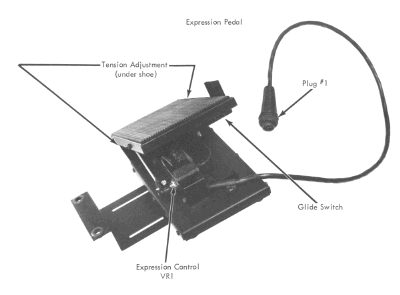



Gibson/Kalamazoo/Lowrey
Guitar giant, Gibson, had it's own entries in the combo organ market of the late 60s. Unlike Fender's offerings, the Gibson G101 was made famous by a well-known organist: Ray Manzarek of the Doors. In fact, it's so well-known today, that the G101 is in high demand, and commands premium prices. Its sibling, the dual keyboard G201, while offering nearly the same selection of sounds and features, is not nearly so well-known. The Gibson organs were made by Lowrey, who marketed two models of their own: the T2, a virtual clone of the Gibson G201, and the T1, also a "duo", but with no counterpart bearing the Gibson name. The first three organs are very similar internally, with the G201/T2 able to duplicate about 95% of the features and sounds of the venerable G101, while the T1 offers a scaled-down selection of features and sounds.
The G101 was introduced as the Kalamazoo K101, but shortly thereafter was renamed the Gibson G101. I had thought it was introduced in the summer of 1967, but one Gibson owner reports that his vibrato board is stamped 22 Jan 1966. The K101 is a rare beast indeed. This is the one used by Ray Manzarek. He initially used a Vox Continental, but eventually decided to replace it. Here's what he had to say in a 1977 inteview in Keyboard Magazine:
"I used a Vox for about two-and-a-half albums. Then Vox was sold to somebody and the organs started falling apart. I'd go out on a gig and in half a set I'd break about six or seven keys. I eventually got a Gibson Kalamazoo. It had a little more versatility than the Vox; it could make the sort of piano-ish sound I used on "Back Door Man" [from The Doors], plus it had a little knob sticking up on the volume pedal which could bend the note a half-step down. We used it on "Not To Touch The Earth" [from Waiting For The Sun, Elektra, 74024]. Even synthesizers don't really do that."
What he's referring to is the takeover of Vox organ production by the Italian company, EME in 1967. Seems like he could have just bought a US or UK Continental with wooden keys, but maybe they were too hard to come by at that point. At any rate, he also needed an organ with a flat top to hold the Rhodes Piano bass, and the Kalamazoo fit the bill. The Gibson G101 is identical, except for the nameplate. This fellow is sometimes mistaken for a Farfisa Compact because the cabinet design, with the fold-out legs and all, is very similar (it fooled me the first time I saw Manzarek playing one).
Thanks to VintageVibe for the pics of this excellent specimen of a G101
And thanks to "gearmod" for these great pics of a Kalamazoo K101:
Controls
Voices: The White tabs are known as the "Flute voices", and the Yellow and Blue tabs are the "non-Flute voices". The Mixture tab adds a combination of 8', 4' and 2-2/3' sounds, but using different filters than the other tabs. It's a very bright-sounding voice.
Glide/Trumpet Wow-Wow: The Glide switch controls the function of a side-lever on the foot pedal. When set to "Normal", it bends the pitch down a half-step, when set to "Trumpet Wow-Wow", it gives what's commonly known as a wah-wah (but it really does sound like "wow") effect to the Clarinet 16; Trumpet 8', Sax Bass and Fuzz Bass voices only. An odd side-effect of the circuitry is that when set to Glide, pressing the lever not only drops the pitch, it also reduces or eliminates the Vibrato effect.
Sustain/Staccato: With the Sustain and Staccato tabs all off, the keys have a rather slow, or "soft" attack envelope. Turning on the Staccato tab makes this attack much shorter, more in line with what you'd expect from a typical combo organ. The Sustain Med and Long tabs add a sustain time after key release. Turning on the Staccato tab along with the Sustain tabs on shortens the sustain time significantly. The "S-St-P" markings on the Trombone and String tabs only indicate that, in conjunction with the Sustain and Staccato tabs, these voices resemble a Piano and Harpsichord, respectively. And they really do - well, in line with the technology available at the time!
Percussion/Repeat: Percussion changes the volume envelope for the non-flute voices to a sharp attack followed by quick decay. When used in conjunction with the flute voices (which are unaffected by Percussion), it provides a sort of Hammond-type percussion effect. Unlike Hammond percussion, it's a re-triggering effect -with an odd twist. If any keys are being held, and an additional key is pressed, the percussion effect re-triggers for ALL the keys pressed. (I'm told this is exactly how Farfisa percussion works, too) When the Repeat knob is on, the percussive attack repeats itself, at a rate determined by the Repeat knob setting. When the Repeat function is on, pressing any key will cause the Percussion to retrigger with the keypress, so you can get some unusual effects by holding and pressing keys off-rhythm from the Repeat rate.
The Percussion/Repeat is probably the one of the most likely features to fail in any of the Gibson/Lowrey combo organs. The heart of the matter is a small metal tube containing a neon bulb and two Light-Dependent-Resistors (LDRs). What usually happens is the bulb darkens over time, or fails altogether, and can't supply enough light to activate the LDRs Replacing this bulb usually solves the problem. Click here to read my Spares & Repairs article on repairing this unit
Bass Octaves: The lowest (black/white) octave is a fixed bass octave. The next octave (grey/white) is switchable between bass and treble, by using the "Extended Bass" switch. Both octaves are fully polyphonic, and both produce the sound selected by the three Bass voice tabs.
Bass Percussion/Sustain: Not an attack percussion like on the Treble side, this Bass Percussion makes the bass notes die down even if you hold the key down. The Bass Sustain operates as-expected - adding a sustain after release, just like on the Treble side.
Reverb: This tab is really just a switch for an external reverb - there's no internal reverb in the G101. According to the owners manual, it was designed to work with either the Maestro Reverb TR-370 amp or the Gibson Combo Reverb amp (neither of which I've ever seen). What the switch does is send the organ output to the "ring" (middle part) of a TRS plug. If you're using a standard 1/4" cable and amp, and you find that you don't get any sound out of the organ unless you turn the Reverb tab on, then you haven't pushed the 1/4" plug far enough into the jack, and it's making contact with the middle contact.
Sounds: Here are a couple of clips of the G101 in action:
Long Sustain demo Lucy in the Sky with Diamond intro
The settings used for these are:
Flute 8', String 8', Nazard 2-2/3'
Vibrato ON / LIGHT / SLOW
Brilliance FULL
Sustain LONG
While the model name would suggest that it's simply a dual keyboard (or, in Combo Organ parlance, a "duo") version of the G101, The G201 looks considerably different on the outside. However, electronically, the two have a lot in common. The G201 one was also marketed by Lowrey as the model T2. The T2 is nearly identical to the G201, lacking only the Fuzz Bass and Sax Bass voices. Both organs came with a dedicated amp, which also housed the power supply, and a bench that folded up and held the bass pedals and volume pedal. The amp had a 12" speaker facing forward, and a 10" horn that projected out the side.
A Kalamazoo K201? Did such a beast ever exist? I don't know, but at least one fellow combonaut thinks he may have seen one:
"Actually, I did once see a 2-manual Kalamazoo (not sure of any model number, but I'm pretty sure it was still branded Kalamazoo rather than Gibson, and it had that lovely gray and green color scheme). Functionally, it was probably the same as the G201 shown. It had 2 manuals (shorter than my K101), and lacked the mixture tab as I remember. May have lacked the Brilliance tab too (?). Otherwise, seemed pretty similar to the K-101."
The G201 and T2 are nearly identical, feature-wise, to the G101. The major exceptions are the lack of the Mixture tab and the extended bass section. The G201/T2 have the added "Manual Attack" tab, plus, the obvious difference of having two, albeit shorter, keyboards. Following is a table summarizing the differences between the three:
| Feature | Gibson G101 | Gibson G201 | Lowrey T2 |
| MIxture Tab | Y | N | N |
| Switchable 2nd Bass Octave | Y | N | N |
| Three Bass Voices | Y | Y | N |
| Manual Attack tab | N | Y | Y |
| Bass Percussion | Y | N | N |
All of the functions work the same as on the G101. The Trumpet Wow-Wow also works on the lower manual, but only on the Cornet 8' voice. The T2's single Bass voice is identical to the String Bass voice on the G101/G201, a plain, flute-like voice.
The range of the upper keyboard corresponds, pitch-wise, to the G101 from the grey F up to the high F
The Manual Attack tab makes the organ's normally soft attack envelope even slower. It interacts with the Staccato tab, so with the G201/T2, you get FOUR levels of attack (wow!):
Manual Attack Slow ON, Staccato OFF: VERY slow
attack
Manual Attack Slow OFF, Stacatto OFF Not quite so slow
Manual Attack ON, Staccato ON: A bit faster
Manual Attack Off, Staccato ON: Very fast
Lower Manual: The lower manual is NOT affected by the following effects: Percussion, Repeat, Sustain, Staccato, Manual Attack. It IS affected by Brilliance, Vibrato, Glide and Trumpet Wow-Wow (on the Cornet 8' only). The Accomp Soft/Full is just a volume adjustment for the lower manual.
Controls
Upper-left bank
Top row:
Bottom row:
Lower-right bank:
Lower-left bank: (Only on the G201 - Lowrey T2 does not have these)
Photos
Gibson G201 (Thanks to Russel for these photos)
Lowrey T2: Here are some of my Lowrey T2:
 |
 |
 |
 |
 |
 |
And here are some more of the Lowrey T2, with companion amp, bench and pedals
Thanks to Tom for these. This organ fell off the back of a truck and was completely demolished. I think a moment of silence may be in order here......... (and no, the parts have long-since hit the dumpster, so don't ask)
Sounds (These were all done on my Lowrey T2)
Upper Manual Voices
AllVoices: Starting at the left, I turn on each voice, hold for a moment, turn Brilliance to Full for a moment, then back off. Then I go to the next voice and do the same thing. Note how the Brilliance has almost no effect on the Flute voices.
String8VsKinura8: Demonstrates the difference between the String 8' voice and the Kinura 8; the latter is more like the G101. At first I thought it was something wrong with mine, but I have since heard from another Lowery T2 owner, and his String 8' also sounds somewhat subdued, so this may just be normal for the T2, and possibly the G201 as well.
Bass Voices
Bass: Bass
octave played legato
Bass2: Bass octave played staccato
BassSustain: Bass octave played
staccato,
with Bass Sustain on
Effects
Staccato/Manual
Attack: This one's kind of subtle. I play a simple 3 note
progression 5 times, once for each of the following combinations of these two
tabs: (I think I had all the voice tabs on, and Brilliance set to Full) Note
that the sound with both On is almost identical to both Off.
Both Off
Staccato Off, Manual Attack On
Staccato On, Manual Attack Off
Both On
Back to Both Off
Repeat1:
All non-flute voices, holding chord, then turning on Repeat, slowly
increasing speed until it stumbles. Note
now the speed slows down at first when the knob is rotated clockwise, then
speeds up again. I don't think this is normal - my T2 does it, but my G101
doesn't. Also note how at the highest speed, it begins to stumble, or
"gallop". I don't believe this is normal (my G101 doesn't do
it), but it's not an uncommon defect (I've heard other Gibson/Lowrey owners
report that theirs does the same thing)
Repeat2: Same as Repeat1, but adding all Flute
voices
Sustain:
All voices, Brilliance Full, Vibrato On, Slow, Light, arpeggiate three chords
three times:
Sustain Off
Sustain Med
Sustain Long
TrumpetWowWow: First, the top manual - Clarinet 16' only, then Trumpet 8' only then both together. Then the lower manual, Cornet 8'
Glide: Self-explanatory. Vibrato is On, Fast, Heavy. You can hear it all but eliminated when Glide is pressed.
Vibrato: Start with Off, then On/Slow/Light, then On/Fast/Light, back to Off, then On/Slow/Heavy, and finally On/Fast/Heavy. (all Colored voices)
Percussion: Arpeggiating a C7 chord, first one note at a time, then holding each note while pressing the second. I do this twice, once with only the Colored voices, and again with the Flute voices added.
Fun with Repeat and Sustain: All voices, Brilliance Full, Repeat/Percussion and Sustain Long. Note how each time a key is pressed, the the Repeat is re-triggered, allowing some rhythmic fun.
Lower Manual Voices
Melodia
Diapason
Viola
Cornet
All Voices
Comparison with G101
In
the following sound samples, the left channel
is the Lowrey T2, and the right channel is the Gibson G101. Played
together, you get a phase-shifting effect, but move your balance control from
one side to the other to compare the sounds of the two organs,
and see that they sound pretty much identical
All Flute voices
All non-Flute voices
A fellow combonaut emailed the Lowrey factory a few years ago, and was told that T1 was introduced in 1964, and that about 2,000 were produced over the next two years. (Thanks, Bill!)
The T1 is sort of a scaled down T2. It does have, however, a somewhat richer palette for the lower manual, with four 8' voices and one 4' voice. I have to assume that like-named features function and sound the same as on the T2.
Controls
The T1 does have the Glide function, but unlike the G101 and G201, it's always on, so there's no separate tab for it. It uses the same type of pedal as the others, with the glide switch to the side. Pressing the glide switch makes the pitch glide up a fifth. The power switch is to the right of the lower manual. This one has a Line Out jack, but apparently earlier models didn't have that, limiting you to using only the companion amp.
(The knob at left is a volume knob added by the owner. Thanks for the pix, Bill!)According to Mark Vail's book, the amp supplied with the G201 was similar to the Sabre Reverb that often accompanied Farfisa Compact Duo.
While the amps don't really look similar (and are DEFINITELY not the same internally), they do share two common traits: 1) both have the rather unusual side-mounted HF horn, and 2) both supply power to their companion organs. The power supplies are massively different, however. The Farfisa supplies only two voltages, the Gibson/Lowrey supplies seven for the organ, plus two more for the power amp!, but it is odd that they would be alike in those two unusual ways. Sounds like there's more common ancestry here than meets the eye. In fact, the Sabre Reverb looks a lot like some Gibson amps of the same era, while the amps for the G201/T2/T1 organs look virtually identical to many Cordovox accordion amps. And to go one step further, the tabs on the G201/T2 organs also look virtually identical to those found on many Cordovox accordions.
All of the Gibson and Lowrey combo organs use the same volume pedal. It's a simple resistive type (not optical), but has an additional switch, actuated by a sideways motion of the foot, which activates the Glide/Trumpet Wow-Wow feature. It's a simple SPST momentary switch. The pedal connects to the organ using a 5-pin Amphenol connector. Normally, the organ will not produce an output signal without the pedal attached, although it's possible to "hotwire" it, if a pedal is not available.
 (Photo from the G201 service manual)
(Photo from the G201 service manual)
How to "Hotwire" the volume pedal socket
If you have one of these organs and it has no volume pedal, chances are you're getting no output signal. There's an easy way to fix that, though.
These pictures depict a Lowrey T2. The Gibson G101 would be similar, but without the large multi-pin umbilical connector.
Bass Pedals:
I'm told that the Gibson/Lowrey bass pedals are identical to those used for the Farfisa Compact series. Of course, the connector is different. You can get the Gibson cable connector from Mouser, and you may be able to find the Hirschmann connectors used for the Farfisa (see my Spares & Repairs page), so it may be possible to convert one set to use with the other organ, or, better yet, make an adapter cable that would allow one set of pedals to be used with either.
Here's the Lowrey T1 pedals:
Gibson G201 pedals:
I have Owners and Service manuals for the Gibson and Lowrey organs available at my Schematics page.